
The Japanese Chin is truly a "Japanese" creation in that it reflects Japanese
sensibilities.
The Japanese created a breed so distinct from other dogs, that in Japan it
was considered something different, distinct from a "dog" which was considered a
working/helper animal whereas the Japanese Chin was considered strictly for pleasurable companionship.
Its distinct appearance and personality eventually captured the hearts of
Japanese Royalty and resulted in ownership being restricted to those of royal and
noble blood.
Each noble house bred to their own standards. Because of this, there are
many variations of the Chin in any area from size to coat density, eye set,
personality, whether they are compact and well-muscled or slender-boned and
fragile in appearance, etc.
Once introduced to the West, a strong desire for the smaller 10 lbs or
less version of the Japanese Chin came to dominate and become the standard of
various kennel clubs around the world.
Professor Ludvic von Schulmuth studied canine origins by studying the skeletal
remains of dogs found in human settlements as long as the
8th millennium BC.[citation needed] The Professor created a
genealogical tree of Tibetan dogs that shows the "Gobi Desert Kitchen Midden Dog",
a scavenger, evolved into the "Small Soft-Coated Drop-Eared Hunting Dog".
From this dog evolved the Tibetan Spaniel, Pekingese, and Japanese Chin`.
Another branch coming down from the "Kitchen Midden Dog" gave rise to the
Papillon and Long-haired Chihuahua and yet another "Kitchen Midden Dog"
branch to the Pug and Shih Tzu.
Though there is some documentation that indicates Portuguese sailors
introduced the breed to Europe in the 17th century by presenting some to
Catherine of Braganza, Queen Consort to King Charles II of England,
there is more credible evidence that the first Chin were gifted by the
Emperor of Japan to an American naval officer, Matthew Calbraith Perry,
when Perry visited the Orient in 1853 to open trade with the East.
Perry was gifted with a total of seven (7) Chin; however, only two survived
the passage back. Again, there is controversy over whether Perry gave the two
to Franklin Pierce, President of the United States, gave them to James Stirling,
Rear admiral of the Royal Navy to take to Queen Victoria, or gave them to his
daughter, Caroline Slidell, after returning from Japan.
Caroline was the wife of August Belmont.

The Chin’s straight, silky hair is usually black and white,
but may be red and white, sable and white, or lemon and white.
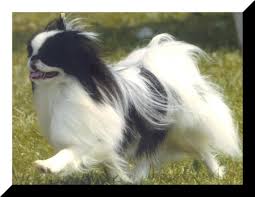 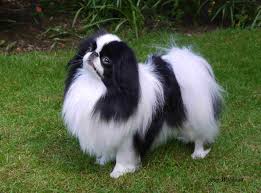
Black and White
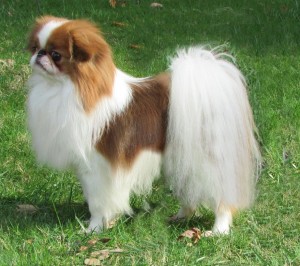 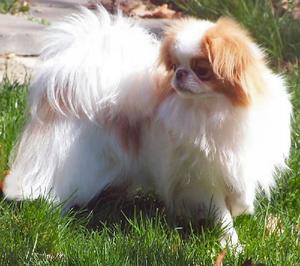
Red and White
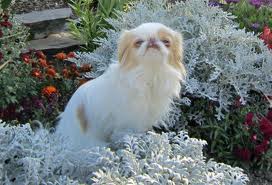 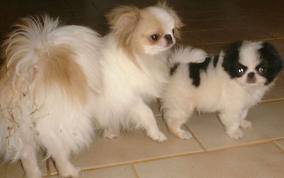
Lemon and White
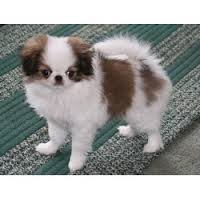 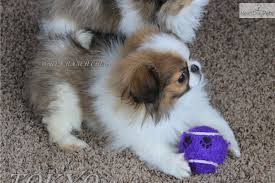
Sable and White
The tail is feathered and carried curled up over the back, with long hair
hanging nearly to the floor. A Chin puppy will lose his full coat somewhere
between 5 and 12 months of age, resulting in near baldness.
This is normal and no cause for concern. He is simply losing his puppy coat,
and the full adult coat may take 2 – 3 years to grow in fully.
Un-spayed females will also molt most of their coats after ending their heat seasons,
generally ending up with thinner coats than males and spayed females.

How does the Japanese Chin act?
The Chin is sometimes referred to as cat-like because he is independent
and washes his face with his paws. In addition, he prefers to rest on high
surfaces such as chair backs and kitchen counters, when allowed.
He can also be found weaving among collectibles on a coffee table without disturbing
even one of them.
In addition, the Chin is alert, intelligent, and independent.
He is a loving and loyal companion dog that does not insist on being a
one-guardian dog. He is equally happy to see anyone, and thus does not make a great watchdog.
The Chin is basically a quiet dog, but enjoys entertaining his humans with his signature
“Chin Spin”, where he turns in fast circles, dancing on his hind legs.
Some Chins even sing while carrying out this maneuver.
The Chin easily adapts to his surroundings, becoming outgoing in a
rambunctious home and quiet and shy in a home that includes only reserved adults.
|